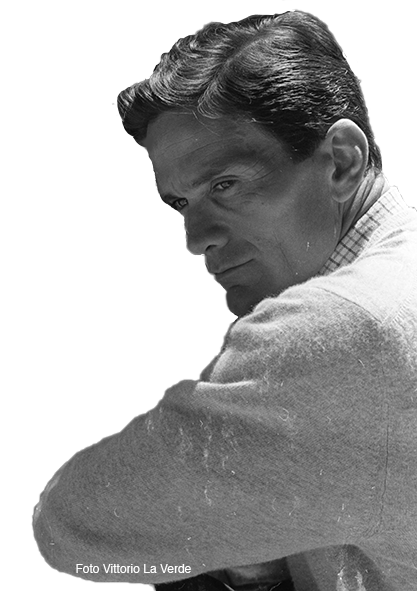Casarsa is a small town situated between Udine and Pordenone. It presents the traditional features of the friulian village: closed courtyards and long stone façades, a real and mythological location where Pasolini developed his first vocation and where his unique poetic intellect was born. He dedicated the collection of poems “Poesie a Casarsa “ to this town. All around the city spreads the level ground, characterized by fodder, plots, vineyards, thickets and poplars. Casarsa is bound to its popular roots and keeps alive its archaic dialect of agricultural tradition.
In Casarsa flow also many rivers such as the Tagliamento with its wide and bright banks. If we look at the letters that Pasolini wrote in the ‘40ies to his academic friends, Casarsa is described as a refuge, a safe shelter, an holiday destination, where he could find a place of one’s own for his studying, reading and exchange of letters with his friends from Bologna. Casarsa represents also his personal exploration of the world that became also the mirror of his soul influenced by the rituals of the local life, village festivals, traditional Sunday balls: we can find these scenerios in the writings of those years, especially in the pages of the diary “Atti impuri”, where the narrative aspect supports the atmosphere descriptions of the mild friulian countryside, the sunsets, the rainy days and the baths in the Tagliamento river.
[blockquote author=”Pier Paolo Pasolini – 1947″ link=”” target=”_blank”]Ho una vecchia passione per la geografia. Da ragazzo mi inebriavo sull’Atlante a misurare con uno sguardo le dimensioni del Mediterraneo o, quanto meno, la campitura verde della pianura padana. […] Devo confessare che certe combinazioni tra l’azzurro perfido del Pacifico e il rosa da calcomania dell’Australia […] erano quelle che suscitavano con più veemenza la mia Sehnsucht geografica. Ciò non toglie però che assai spesso […] mi decidessi a sfogliare l’Atlante fino alla figura dell’Italia e lì cercassi con avidità insana i cerchiolini delle città a me più care. Mi sentivo allora crudelmente offeso che Bologna non fosse segnata col bel quadrato irregolare di Roma, Milano o Genova […], del resto ero molto compensato dal fatto che Casarsa fosse segnata, anche se con un anello minuto, nel centro del Friuli e che da essa dipartissero, fili di una grossa ragnatela, i simboli delle linee ferroviarie. Tutto questo costituisce uno dei luoghi della mia infanzia senza ignoto, senza tempo perduto: sono nitidissimi nel panorama del mio passato, la loro gioia non resta affatto incomunicabile, anzi mi si rinnova nella memoria con tutta la sua purezza.[/blockquote]
The sites forming part of the “anello minuto”( places around Casarsa), that Pasolini had in his imagination, have now become the five locations of our itinerary. This is the sentimental “topography” of the landscape and of Pasolini’s literature: the “rogge” ( artificial canals) , the rows of mulberries, the little Churches hidden in the countryside…. All the features of Pasolini’s poetry and memory barely survive to the passage of time and to the inevitable progress changes. Literature is the means that leads into this landscape and guides the imagination beyond those tiny streets perfumed of grass and primroses that route in the countryside. The remembrance of the landscape that Pasolini regretted in the late ‘60ies, was re-experienced thanks to literature that, describing in detail what seem to be invisible to the eye, surrounded the landscape in a complete harmony. This became the starting point for the researches of a landscape identity, which slowly dissolved over the time. The itinerary through the places of Pasolini’s life and work develops in 5 steps. Each one describes the most important moments of the poet’s literary and intellectual growth in Friuli: from Casarsa to Versuta ,San Giovanni, Santa Croce Church and the Cemetery where Pier Paolo Pasolini lies. The territory of Casarsa and the friulian countryside offer the visitors a particular breathing space and an extraordinary chance to reflect on the link between landscape and literature throughout this route looking for the people who lived in that period at the threshold of the oblivion, the characteristic glimpses and tastes associated with poetry. This will be a sort of walk through the pages of a book, in a place where the poet’s visible and emotional experiences are still preserved. The history of the friulian period offers a schematic but detailed summary of the most important events of poet’s life in Friuli that goes from 1943 to 1949. The maps help the virtual visitors to organize a “real journey “ in Casarsa della Delizia, in the heart of Friuli, in search of the sentimental “topography” that fascinated Pier Paolo Pasolini at the beginning of his poetry.
[divider height=”10″ style=”hr_narrow ” line=”default” themecolor=”0″]
info: telephone number : +39.0434.870593
e-mail : visiteguidate@centrostudipierpaolopasolinicasarsa.it



